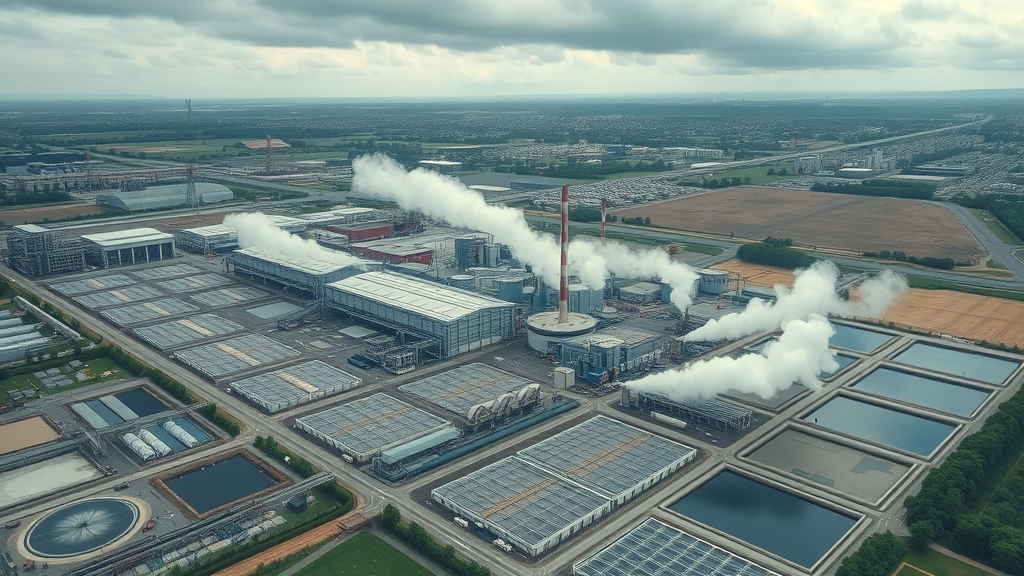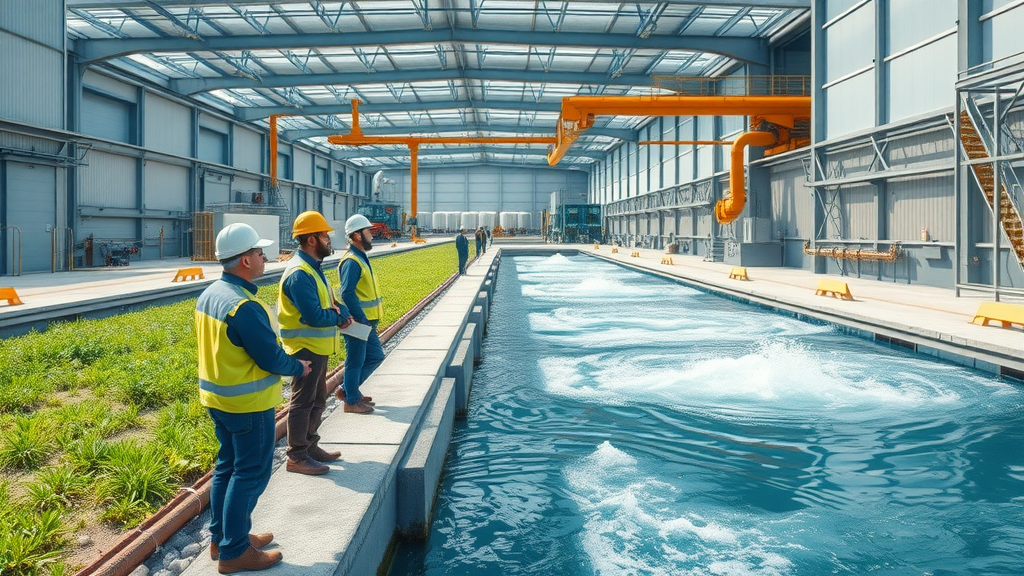Did you know that failure to comply with industrial wastewater regulations can lead to costly fines, public exposure, and even forced plant shutdowns? Industrial wastewater non-compliance is a critical issue faced by many manufacturers and facilities, especially under stringent local and federal mandates. In this comprehensive guide, we explore what industrial wastewater non-compliance entails, the compliance notification process, common treatment challenges, and how expert support can help businesses avoid severe consequences.
Startling Facts About Industrial Wastewater Non-Compliance
Industrial wastewater non-compliance frequently arises when factories and plants exceed regulated limits on key pollutants such as sulfides, total suspended solids (TSS), chemical oxygen demand (COD), biological oxygen demand (BOD), and pH levels. These pollutants, if not properly treated and controlled before discharge, can cause severe environmental harm and violate regulations set under the federal Clean Water Act.
Many industries remain unaware of how their operational activities—like deep tank cleaning or washing processes—can spike pollutants. For example, irregular cleaning can flush trapped sulfides into wastewater, breaching discharge limits temporarily. Such events often trigger regulatory warnings that require swift action to retain compliance. Ignoring these can lead to escalating notices, costly penalties, and public disclosure of violations, which can damage corporate reputation substantially.
Understanding the risks and starting early compliance efforts can prevent such outcomes, making knowledge about wastewater management essential for all industrial plant managers and environmental health and safety (EHS) personnel.

Understanding Industrial Wastewater Non-Compliance and Regulatory Framework
Steve Manii of CSI Environmental explains, "The federal mandate under the Clean Water Act sets the baseline, but counties like LA and Riverside can impose stricter standards, making compliance a complex but critical task for industries."
Industries across the United States must comply with wastewater discharge limits primarily guided by the federal Clean Water Act—a law that establishes baseline pollution control standards nationwide. However, local agencies in regions such as Los Angeles and Riverside counties can enact more stringent wastewater regulations, reflecting the specific environmental sensitivities and urban infrastructure challenges of their areas.
This multi-tiered regulatory environment means that plant managers must not only understand national standards but also keep abreast of local permit requirements. These permits specify allowable levels for various pollutants, creating complex compliance landscapes. Failure to meet these standards constitutes industrial wastewater non-compliance and subjects facilities to enforcement actions from environmental authorities.
Key Industrial Wastewater Treatment Systems and Their Role in Compliance
To meet these regulations, industries employ diverse wastewater treatment systems designed to reduce or eliminate pollutants before discharge. These include physical removal systems like sedimentation tanks that reduce total suspended solids, chemical treatment units that neutralize sulfides via oxidizers like chlorine or hydrogen peroxide, and biological treatments targeting soluble organic compounds to lower COD and BOD levels.
Each system plays a critical role in maintaining compliance by ensuring discharged effluent meets permitted quality standards. Modern treatment systems are often tailored to a facility’s specific effluent characteristics and can involve a combination of technologies to address all regulated parameters effectively.
The Compliance Notification Process: From Sampling to Warning Letters
According to Steve Manii, "If sulfide levels is high, businesses must explain why and demonstrate corrective actions to regulators."
The compliance journey typically begins with regulatory agencies collecting samples—such as 24-hour composite water samples—at industrial discharge points. These samples measure pollutant concentrations including fats, oils, grease (FOG), TSS, COD, BOD, sulfides, and pH levels.
If the sample results violate permit limits, a formal process kicks in. Regulatory agencies issue a written warning that details the specific parameters out of compliance, outlines corrective action plans to be implemented, and requires a retest. This retesting confirms whether the business successfully addressed the violation.
For instance, if sulfide levels spike during an unusual deep tank cleaning operation, the company can explain this transient cause to regulators. They must then prove the anomaly is not a recurring issue by showing improved results in subsequent tests. Failure to provide plausible explanations and solutions leads to escalating enforcement.
Consequences of Continued Industrial Wastewater Non-Compliance

Ignoring compliance issues worsens regulatory repercussions. Upon receiving a warning, businesses must act quickly to correct discharges. Monthly composite samples continue to monitor the facility’s discharge quality. If violations persist, regulators issue increasingly stringent notices warning of possible fines, additional fees, or even forced shutdowns of operations.
Beyond financial penalties, non-compliant facilities risk public exposure via publications such as LA County Sanitation District’s non-compliance announcements, which list violators in media outlets like the LA Times. This harms corporate reputation and can deter customers or partners. Ultimately, persistence of violations can lead to the halting of production until compliance is restored, causing significant operational and economic losses.
Common Industrial Wastewater Compliance Issues and Solutions
Common problems include elevated sulfides releasing odors and toxins, excessive TSS causing sediment accumulation in sewer lines, and imbalanced pH levels damaging sewer infrastructure or treatment facilities. Chemical oxygen demand and biological oxygen demand levels frequently reflect the presence of organic pollutants that require specialized treatment techniques.
Effective solutions involve a combination of equipment upgrades, chemical dosing (such as chlorine injection for sulfide neutralization), and enhanced process controls. For example, CSI Environmental offers tailored consulting to identify specific causes and recommend cost-effective strategies—helping plants achieve compliance and reduce surcharge costs by lowering pollutant loads up to 95% in some cases.
Who Receives Compliance Notifications and Their Responsibilities
Compliance notifications typically go to the company representative listed on the wastewater discharge permit. In many organizations, this person holds a title such as Environmental Health and Safety (EHS) Manager, Plant Manager, or Maintenance Supervisor—responsible for overseeing wastewater treatment operations.
These individuals must take responsibility for responding to warnings, coordinating corrective actions, and liaising with regulatory authorities. Their role is vital in ensuring treatment systems function correctly and necessary documentation is accurately maintained to demonstrate compliance to inspectors.

How CSI Environmental Supports Industrial Wastewater Compliance
Steve Manii states, "We often serve as the liaison between businesses and regulatory agencies, helping to interpret lab results and develop effective treatment strategies to ensure compliance."
CSI Environmental, Inc., led by Steve Manny, specializes in helping industrial facilities navigate regulatory complexities surrounding wastewater compliance. They act as an expert third party, analyzing lab reports, interpreting regulatory notices, and advising on remedial actions tailored to each facility’s unique challenges.
Working closely with regional authorities, CSI Environmental can communicate directly with regulators, easing businesses’ administrative burdens and expediting compliance solutions. Their consultative approach has helped many clients avoid fines and optimize treatment systems for sustainable operations.
Required Documentation for Compliance Assessment
To begin an effective compliance assessment, CSI Environmental requests key documents including:
Recent third-party laboratory test reports covering the last 3 to 6 months
Official compliance warning letters or notices from regulatory agencies such as LA County Sanitation District or Inland User Authorities
Surcharge statements detailing current pollutant loads and associated fees
Details of existing wastewater treatment and monitoring practices
Having this information allows for a comprehensive evaluation of the plant’s discharge relative to permit limits and identification of appropriate treatment upgrades or operational changes.

Parameter |
Permitted Limits |
Common Treatment Solutions |
|---|---|---|
Sulfides |
Varies by permit, typically ≤ 1 mg/L |
Chlorine/hydrogen peroxide dosing; aeration |
Total Suspended Solids (TSS) |
Typically ≤ 30 mg/L |
Sedimentation tanks; filtration systems |
Chemical Oxygen Demand (COD) |
Varies, often ≤ 250 mg/L |
Chemical oxidation; advanced biological treatment |
Biological Oxygen Demand (BOD) |
Usually ≤ 30 mg/L |
Activated sludge systems; enzymatic treatments |
pH |
6 to 10 standard units |
Neutralization tanks with acid/base dosing |
People Also Ask (FAQs) About Industrial Wastewater Non-Compliance
What is wastewater compliance?
Wastewater compliance means adhering to regulatory standards concerning the quality and constituents of discharged industrial wastewater to protect public health and ecosystems.What are the problems with industrial wastewater?
Industrial wastewater can contain harmful pollutants such as heavy metals, organic compounds, oils, and toxins that damage environments and infrastructure if untreated.What is included in non-compliance?
Non-compliance includes exceeding discharge limits, failure to report samples, inadequate treatment, or violating permit conditions.What is significant non-compliance?
Significant non-compliance refers to serious, ongoing or repeated violations that pose a high risk to environmental or public health, often leading to intense regulatory actions.
Key Takeaways on Industrial Wastewater Non-Compliance
Non-compliance risks fines, plant shutdowns, and reputational harm.
Regulations come from federal and local bodies, with local standards often stricter.
Compliance requires effective treatment systems addressing sulfides, TSS, COD, BOD, and pH.
Regulatory process involves sampling, warning letters, action plans, and retesting.
CSI Environmental offers expert support, serving as liaison and consultant to businesses.
Conclusion: Ensuring Compliance to Avoid Consequences
Act now: Regularly review discharge permits, monitor wastewater quality, and seek expert help early to prevent costly compliance failures and protect your business’s future.
Get Your FREE Compliance Assessment Today
Don’t wait for regulators to find your non-compliance. Contact CSI Environmental today for a free industrial wastewater compliance assessment and start your journey toward meeting discharge standards with confidence.
Get Your FREE Compliance Assessment | Phone: (800) 690-2436
Non-compliance with industrial wastewater regulations can lead to severe consequences, including substantial fines, operational shutdowns, and reputational damage. For instance, in November 2024, Phillips 66 was indicted for violating the Clean Water Act by unlawfully discharging 790,000 gallons of industrial wastewater into the Los Angeles County sewer system, with oil and grease concentrations exceeding permitted levels by up to 329 times. (reuters.com) Similarly, in January 2023, Partridge-Sibley Industrial Services, Inc., a Mississippi-based company, pleaded guilty to illegally discharging industrial waste into Jackson’s wastewater treatment system, contributing to significant environmental harm. (apnews.com) These cases underscore the critical importance of adhering to wastewater discharge regulations to avoid legal repercussions and protect environmental and public health.
 Add Row
Add Row  Add
Add 




Write A Comment